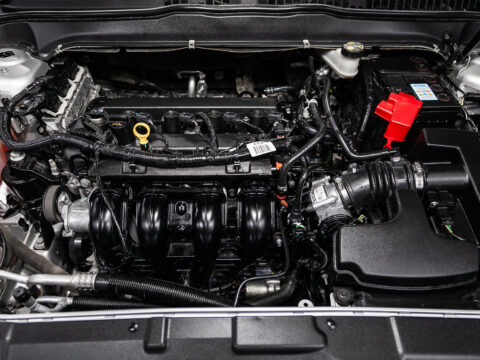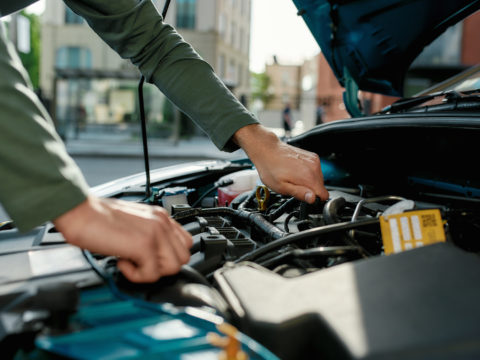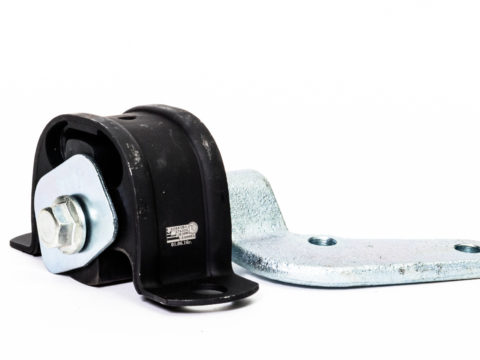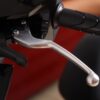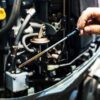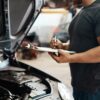Car troubles are no fun! But when they happen, you need to be able to access important information that will help mechanics fix your car quickly. Something of importance you will need to know is what type of engine your car has. There are many ways to check this, but some are easier than others!

How to find out what kind of engine your car has
If you need to get your car checked out, auto parts stores will ask you for the year, make, and model of the vehicle. They will also need to know what kind of an engine it has. If you don’t know what is under the hood or how to find that information, you can check the engine size by looking at the Vehicle Identification Number (VIN).
This number is the identification for your vehicle. It will also help you discover the engine size. The number is on the lower corner of your windshield on the driver’s side is a series of numbers and letters. The tenth character from the left will tell you the model year, and the eighth character from the left is the engine codes.
If you tell the auto parts store or the mechanic those two numbers, they will be able to help you out!
Checking engine size by VIN
Here is a step-by-step process for how you can check the engine size using the VIN:
Step 1:
Locate the VIN on the lower corner of the windshield on the driver’s side. If it’s not there, you can also find it on the driver’s side door frame. Other vehicles may have it on the metal plate under the hood. It’ll be near the engine.
Step 2:
Write the VIN down on a piece of paper. Double-check it to make sure that you copied it correctly. Even if one number is wrong, the VIN will not be helpful, and you won’t be able to check the engine size.
Step 3:
Enter the VIN into decodethis.com. Press “decode” and on the next screen may ask you to choose which trim best matches your vehicle. Choose the option and click “select trim.” Next, scroll down until you see your vehicle’s general information. The engine size information will be there.
Step 4:
Take that information to the auto parts store or the mechanic! They will be able to use it to help you get a new part.
How to find the engine number on the engine block
Here is a step-by-step process on how you can get the engine number on the engine block:
Step 1:
Open the hood and find the engine block. The number is on the metal sticker that is on the engine block. It may be on the left-hand stride of the engine. Car manufacturers say they have made it visible. The position of the engine plates can vary between various engines.
Step 2:
Know that the engine number is made of several characters, including letters and numbers. It’ll look something like this: KJ16345U173656P. It will always have the following:
- The list number of the build list, which is usually two to four letters followed by four or five numbers
- A letter that identifies the country
- The serial number
- A letter indicating the year manufactured
Double-check to make sure you have the correct number!

Engine number example
Here are a few engine number examples:
| Typical examples of engines | Serial numbers |
| Small and medium engines | XX99999X999999X |
| 1300 Series | XXXX9999X99999X |
| 1500 Series | XXXX999X99999XX |
| 1600 Series | XXXX999X99999XX |
| 2000 Series | XXXX9999X99999X |
| 4000 Series | XXXX9999X99999X |
| Older engines | XXX999999X9999X |
How to find out what cylinder your car is
Nearly all cars have four, six, or eight cylinders. An engine with six cylinders is called a V6 engine. It has six cylinders and is set in one of two ways. It’s either at an acute angle or made with a straight-four engine with an additional two cylinders.
The four cylinders are called a straight-four engine. All cylinders are designed to be in a straight line and are standard on cars with a 2.4-liter engine displacement.
Lastly, an engine with eight cylinders is called V8. It’s the same as the V6, but it has two more cylinders. The cylinders used on the V8 are straight-eights and mounted left to right.
If you need to identify what cylinder your car is, you will need to figure out how many spark plug wires are connected to each cylinder. Usually, there is one spark plug per cylinder head.
- Open the hood of your car: That is what covers the engine’s compartment. Make sure the hood is secure before sticking your body under it.
- Look for the spark plug: The spark plug is connected to the cylinder. It is there to ignite the fuel into a motive power through an electric spark. The wires can be seen either on the top or the side of the engine – they are usually black, blue, or red. Each spark plug is connected to a distributor cap or the cylinder head. The wires are usually numbered, as well. Only in V6 and V8 engines will the spark plug wires be on both sides of the engine.
- Time to count: Once you have identified the spark plugs, count how many you see on the engine. It should add up to an equal amount.
- Check to see if the engine is numbered: If you check the engine’s surface, the engine will have its cylinders numbered.
What size engine does my car have?
If you need to determine the size of your engine, you can look for that on your window sticker. It will be listed under the vehicle description on the top. If you don’t have a window sticker, you can check the VIN or the vehicle’s manual.

